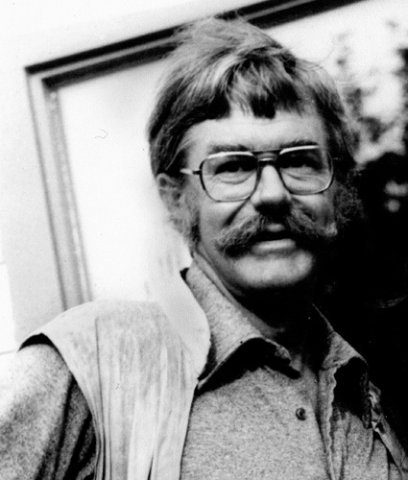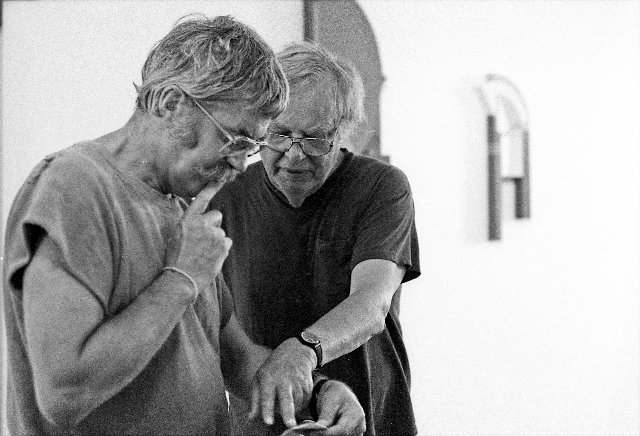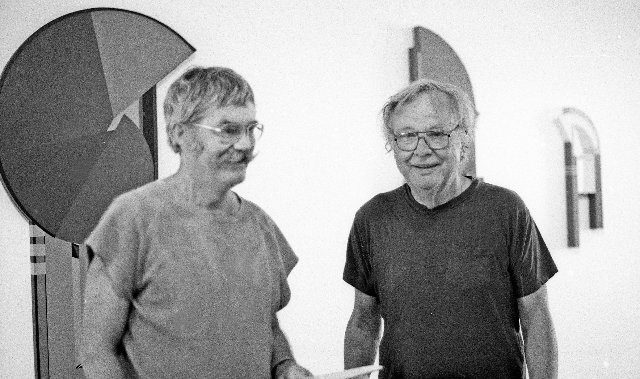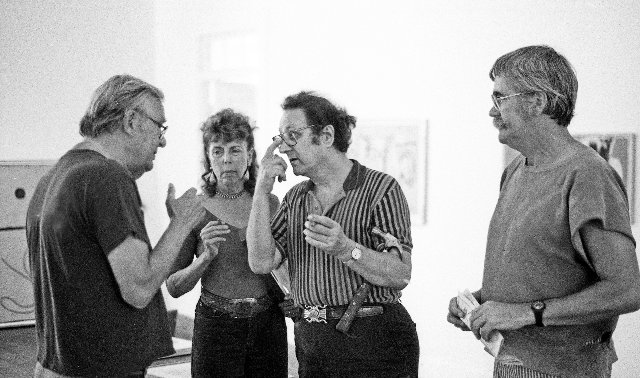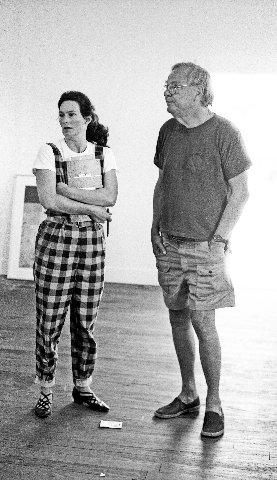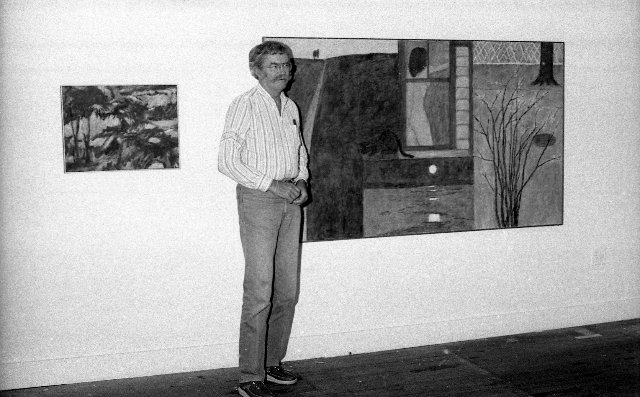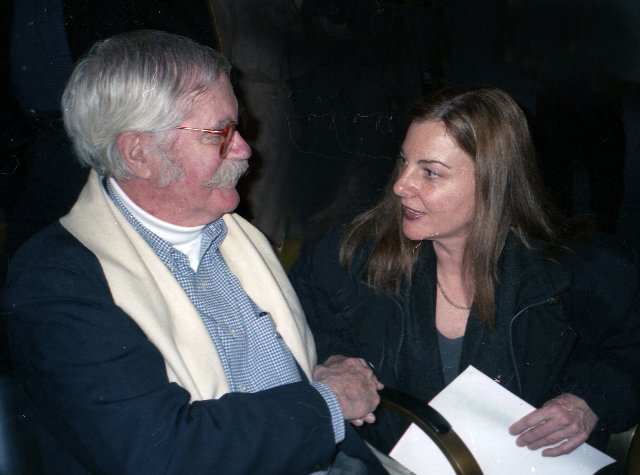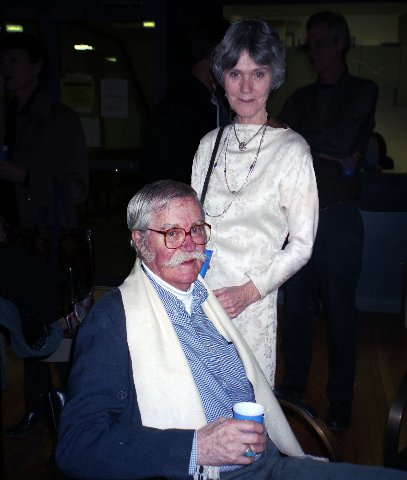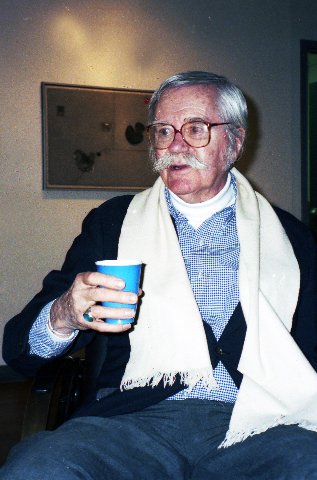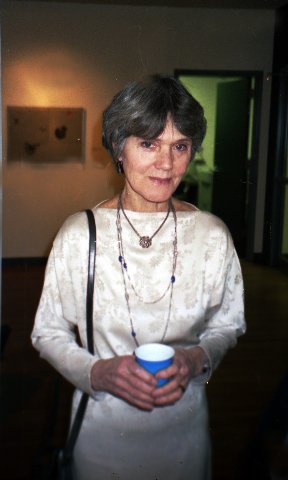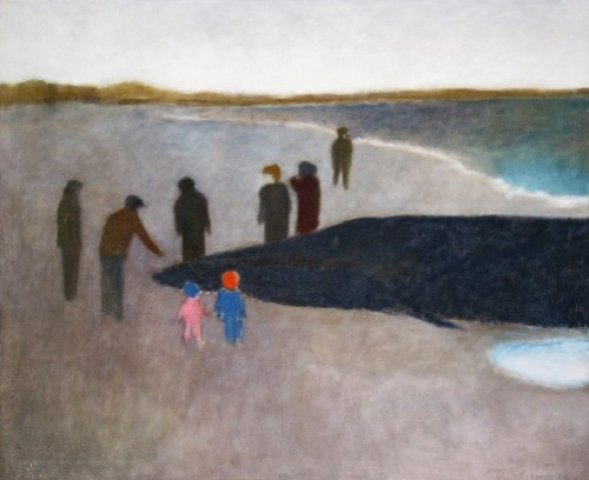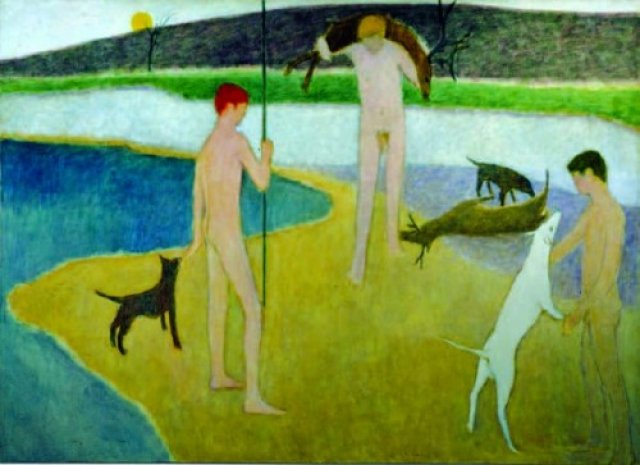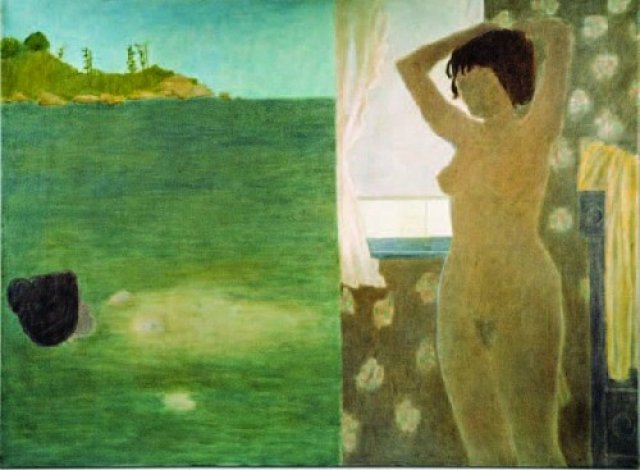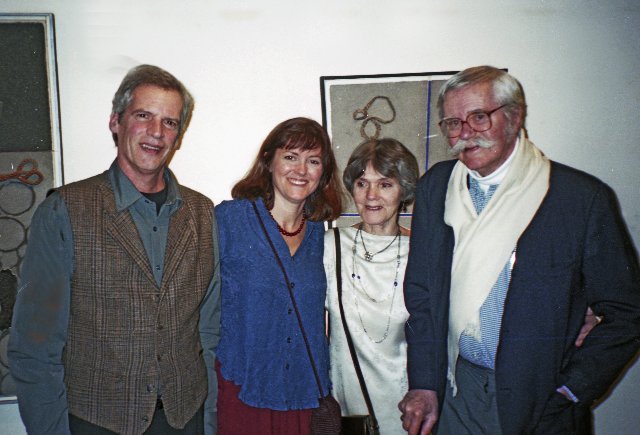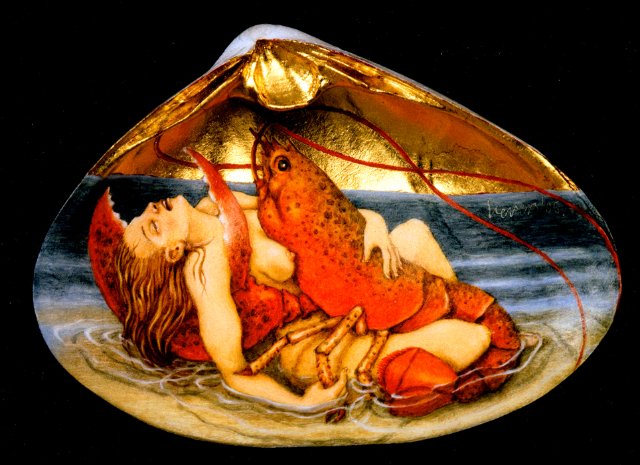Provincetown Artist Tony Vevers
Showed with Sun Gallery and Long Point Gallery
By: Charles Giuliano - Sep 17, 2024
Tony Vevers (1926-2008) was born in England. Evacuated to the U.S. in 1940, he served in the army as a Staff Sergeant during WWII. He attended Yale on the GI Bill. He taught at Purdue University from 1964 to 1988 with summers in Provincetown. There he showed with Sun Gallery which included emerging figurative expressionists. Later he was a founding member of the cooperative Long Point Gallery.
Charles Giuliano We are sitting in Long Point Gallery. You were one of its founders.
Tony Vevers It started in 1977. Leo Manso had a school here. He rented as now do we from the American Legion. His partner, Victor Candell, died the year before. Leo felt it was time to close the school but he didn’t want to give up the space. At that time there were very few galleries in Provincetown. The art scene was on the down swing. Our thought was to have a good gallery which showed local artists and somehow upgrade the art scene. We were trying to establish a level that was missing. After a great deal of organization in New York the group was formed.
Everyone wintered there except for me and (Varujan) Boghosian who taught at Dartmouth. (Robert) Motherwell winters in Connecticut and I teach at Purdue in Indiana. I’ve summered here for 20 years.
Mostly I teach art history. Before that I did carpentry.
CG Do you have degrees in art history?
TV No. I got into it because I had always been interested. I teach 19th and 20th century as well as Art Since 1945.
Prior to Long Point, I organized a couple of shows in 1974 and 1976 for HCE Gallery with Nat Halper. I rented the old HCE Gallery and also put on a show at the Tennis Club.
(It was the first exhibition in the space which later housed Group Gallery, directed by the late Grace Consoli, then the renowned DNA Gallery. Tony was a member and avid tennis player.)
These were one man shows but they gave the idea that there was room for a gallery. There was no gallery showing contemporary work. If you look back at 1960-62 there were 20 or more galleries. There was tremendous vitality but the art world got bigger. With a bit more money, what was going on here was small stuff. Martha Jackson and Virginia Zabriski had galleries here. The Sun Gallery closed in 1962 (with two more years under artist Bill Barrell) and HCE in 1966. The scene withered away. Everyone in Long Point Gallery was here but with no place to show.
CG What about the Provincetown Art Association and Museum?
TV It was in doldrums then but has picked up the past five or six years. It is now more interesting and vital. I think Long Point had a lot to do with their revitalization. After we started the Group Gallery was formed at the Tennis Club. Every year there seem to be more new galleries. Two new galleries opened this year Massimo and West End Gallery moved to the East End. There is a gallery across the way from us (Commercial Street) which has just opened. It’s where West End Gallery had an annex last season. There is a lot of vitality and the impetus has to be credited to Long Point.
CG Can you describe the first season. Were egos an issue? Did everyone agree on the need for the gallery?
TV We had an overall plan and created a schedule. There were to be so many group and one person shows. We had a director who had been involved with New York galleries but we had no idea what was going to happen. I think we are surprised to be going strong eight years later. The sense of camaraderie has really grown. I hadn’t known all the artists. Carmen (Cicero) and I had met but I didn’t know him well. Fritz (Bultman) I had known since 1951 and I’ve known Bob Motherwell since 1957. Boghosian I have known for some time as well as Budd Hopkins.
CG Was there a common aesthetic and generational factor?
TV Perhaps it was an age thing as we were in our 60s. Budd is the youngest and Leo is 72.
CG So the spread was 50’s through 70’s.
TV Boghosian, Ed Giobbi, myself and a couple of others were within a year or two. We are all in our late 50’s give or take a year. We are all quite different. Nora (Speyer died at 101 in 2024) paints quite realistically as does her husband Sideo (Fromboluti). We shared a sense of self confidence. One person, Rick Klauber, dropped out. He was the youngest. He and his wife moved outside of the area so quite rightly he left the gallery. The only rule was that artists had to be residents of this area.
CG Are you open to new members?
TV We have invested so much effort and commonality that it would be a mistake to admit one artist and not another.
Since the first year we have published three sets of posters. This is another thing we have in common. It’s unique to a gallery such as this as we make a poster to sell that helps to finance our operation. It came out of our first meetings. As a cooperative we have annual dues which are now $400. In the beginning we put money in as it was needed. We had to remodel the space and put in lighting. In the first year we each put in $500.
CG There was no assurance that it wasn’t money down the drain.
TV Half way through the first season we realized that there would be a lot of expenses. That’s when the director Rick Librizzi came up with the idea of a poster. We made 14 different originals and sold each one for $300. They weren’t prints but rather originals including drawings and paintings from each member. So each poster was unique. They sold quite quickly. We made a print of the original and sold that. The prints sold for $100 to $125. The edition wasn’t very large. They quickly sold out.
The next year we were more organized. We created a silk screen print with four colors. They sold for more. The edition was 75 and they sold for $500.
CG How many members are there in Long Point.
TV Right now thirteen.
(1977-1998. The founding members were Varujan Boghosian, Fritz Bultman, Carmen Cicero, Sideo Fromboluti, Edward Giobbi, Budd Hopkins, Rick Klauber, Leo Manso, Robert Motherwell, Paul Resika, Judith Rothschild, Sidney Simon, Nora Speyer, and Tony Vevers. Later in the gallery's history Robert Beauchamp, Paul Bowen, Gilbert Franklin, Dimitri Hadzi, Renate Ponsold, and Michael Mazur also became members. Some notable friends of the gallery were Nassos Daphnis, Jack Tworkov, and Myron Stout.)
The last poster was “A Grey Day” which was named for a show that we had. It was our most popular poster. We have sold 50 of them at $150 each from an edition of 125. Sales of the prints have paid most of our bills. We have a regular assessment just to assure that we have money in our account. This year we opted to pay dues in addition to print sales to have a steady cash flow. The gallery takes 25% of sales. The artist gets 75%, the director 10% and 15% for the gallery. Last year was our most successful (1983) and we had $40,000 in sales.
CG What are the annual operating expenses?
TV Last year it was estimated to be $12,500. This year, give or take, it should be about that. The season runs from July 4th through Labor Day. There is a deficit which we cover with dues.
CG Do some of the artist sell while others do not?
TV That’s hard to say. Over the years we have sold about equally. Of course Motherwell’s paintings sell for a lot more than the rest of us.
CG I understand that he has an agreement with Marlborough Gallery that he can sell one painting a year but there is no limit on selling prints.
TV He can sell prints. I believe that’s the agreement. He enjoys the friendship of the group. He was a founding member of the Artist’s Club in New York. He has always liked a sense of community. Motherwell commented that he likes the meetings that we have every two weeks. They are held in the afternoon and we have wine and cheese. We discuss business and then stay and chat for an hour or so. It’s a lot of fun and we enjoy getting together. Every now and then we go to a restaurant or have a party. We have festivities every summer. Sometimes the gallery picks up the tab or we pay for it ourselves. It’s why we are loathe to take on new members because we have this shared history.
CG Of course that creates an incentive for artists to found other galleries.
TV Group Gallery at the Tennis Club was very much modeled on us. Coops are not new. There was Tanager gallery in New York in the 1950s which showed young artists. The difference is that we are older and not just in it to show. We are in it because we enjoy each other.
CG There is an analogy of out of work musicians banding together to open a nightclub.
TV In the 1950s Tanager and Hansa galleries were important for showing young artists. There were 10th Street galleries that generated a lot of activity. A complaint about Long Point is that some of the shows have been similar. For a long time we just had group shows though lately they have themes. We found that by having themes the shows became more vital and they are more fun to do.
CG How and why did you first come to Provincetown?
TV We first came in 1955. My wife (the artist Elspeth Halvorsen) had just had our daughter Stephanie who draws well but is more interested in performance. Tabitha, our second, is an artist. We had been living in New York and wanted to move to the country. We had the offer of a free place on the water. That was the winter of 1955-56 and we accepted the offer which came through Milton Avery’s daughter. I had known Milton for some time and he knew that we wanted a place. Somehow they heard of this free place and passed along the word. Within a day or two we loved it and felt very much at home. There were very few artists around in the winter. We came in the fall.
CG Who was around?
TV Myron Stout had just moved here. I knew him from the City. Jim Forsberg was running the Studio Shop so we met him. Ciro and Sal had opened a restaurant. (Ciriaco Cozzi and Salvatore Del Deo met in Provincetown in 1947 as students of Henry Hensche.) Taro Yamamoto was around. Karl Knaths was from the older generation.
CG Edwin Dickinson?
TV He was more of a Wellfleet artist. I didn’t meet him until some time later. Of course there was Karl, Phil Malicoat (a student of Charles Hawthorne who settled in 1931), Bruce McCain (1900-1990 a Hawthorne student) and Eddie Euler (Edwin Reeves Euler, 1913-1980). That was the winter group.
It’s different now (Fine Arts Work Center) with a lot of young artists and people interested in theatre. There are probably several hundred people in the winter. I was here two winters ago and it seemed to be very active. Of course a lot of people come for weekends but the whole thing appears to be different.
CG What were your circumstances in 1955?
TV We managed to save about $500. With a free place and living frugally we were able to scrape through until spring. Then I got a construction job but it was tough going. I had been selling quite well showing in several galleries, particularly, the City Center Gallery which showed young artists. I had a one man show at Tanager Gallery. Showing in New York I was doing pretty well and lost ground when I moved here but at the time I thought it was worth it. More or less on my own I started painting as a teenager. I had a lot of support from my school (Hotchkiss). When I graduated I won a prize which helped me. I was in the service in Europe for two years then went to Yale when I got home. I majored in painting and drawing. It was a Beaux Arts program but very thorough. It was just before Josef Albers (1888-1976) and very 19th century.
CG Who was there?
TV Dean Keller was an instructor. His teaching was modeled after Bridgeman who was a draughtsman. He also taught life painting. They had a terrific art history program with Vincent Scully and George Heard Hamilton. So I had a very good art history background that came in handy later. I went to Europe for a couple of years and studied at the academy in Florence. When I returned to New York I studied with Hans Hofmann. That brought me back into the 20th century. I didn’t study with him in Provincetown.
More than anything else what I learned from him was how noble it is to be an artist. I think I understood what he was teaching in terms of space. I liked that he always talked about Titian and Rembrandt.
CG Did you see his work? He didn’t show for a long time.
TV He was just beginning to show. I remember seeing his work at Kootz. It was very different from what he did in class. He was a very inspiring teacher. When he walked into the room you could hear a pin drop. I studied drawing and we worked with the model in charcoal. Push/ Pull entailed color so he didn’t talk about that. I think the Push/Pull thing has been overworked. I run into faculty in the Midwest who teach Push/Pull and they don’t know what they’re talking about. It was a very logical approach to color but I didn’t study painting with him. One thing that Hofmann emphasized was the space around the model. You had a total sense of the picture plane.
CG Do you teach studio classes?
TV Yes, life drawing.
CG Let’s go back to that first ‘free’ winter. Did you have to move out in the summer?
TV In the spring all of our friends from New York came looking for places. Angelo Ippolito (1922-2001 an abstract expressionist) was a friend. Now he lives and teaches in Binghamton, New York. Then Miles Forst (1923-2006) and Steve Pace (1918-2010) who was one of my best NY friends. All of these people were coming and it felt like being back in New York again.
CG Were Jan Müller and Bob Thompson around at that time?
TV Bob didn’t come until after Jan Müller’s death in 1958.
CG I thought they were friends.
TV They may have met through Dody who was Jan’s widow.
CG Did you know them and what can you tell me? They were leading figurative expressionist artists. You work in that manner.
TV No, my work developed when I was in Italy in 1952. I was very close to Steve Pace. He was older than me and moving into abstract expressionism. I started working in that manner and when I got back to New York was hook, line, and sinker into the de Kooning splash thing.
CG Is the small black and white painting in the gallery indicative of that?
TV Right. It developed out of what I had been doing in Italy. I was very involved with landscape. I was still painting that way when we came here. After getting married I was drawn to the figure. I developed as a figurative artist around when we came to Provincetown.
CG Was your wife the model?
TV I guess she was, not directly, but indirectly. I was also interested in painting as a mythological idiom.
CG How did you meet Elspeth?
TV We met at Monhegan Island, Maine. I went there one summer to paint and shared expenses with Steve Pace and another artist, John Collins. On our second night we went to a dance. I started dancing with Elspeth and that was it. Six weeks later we married. We’ve been married for 30 years. I was then about 27 or 28.
She had studied at the New School and Art Students League. When Stephanie was born in 1955 she decided to be a full-time mom which was the case for 15 years. Then she took up photography and sculpture. She shows in Wellfleet at Visual Images Gallery as well as in New York. She has a very busy career.
CG Can we get back to Thompson, Müller, and figurative expressionism?
TV When we came here one of the first things we heard about was Sun Gallery which opened that summer. (1955) The people who ran the gallery, the artist Yvonne Andersen and poet Dominic Falcone, came to see my work. I showed at Sun Gallery. (1955-1959)
I was included in a couple of group shows. I had already met Jan Müller through his fiancé because they both knew Steve Pace. I got to know them and the Sun Gallery artists that included Lester Johnson, Alex Katz, and George Segal. Red Grooms joined later.
CG Did you know Earl Pilgrim?
TV I met him later in New York. The Sun Gallery space was originally his jewelry shop. He also painted. Sun Gallery was unique because they said they weren’t interested in making money. They believed in art that was expressive but not that much abstract. I was a part of a number of young artists who used the figure but respected and admired abstract expressionism.
There was a second generation of abstract expressionism and even a third which included Alfred Leslie who I got to know quite well. He was here in the summer of 1956. He drove up in a jalopy bringing Franz Kline with him. He had a great time and stayed the summer. There was a party every night. Dick Bellamy came in ’57 or ’58. It was a terrific summer with lots of picnics.
(Richard Bellamy, 1927-1998, ran the seminal Green Gallery from 1960-1965. Then he ran Noah Goldowsky for several years before founding the vast Oil and Steel. He first visited Provincetown in 1949. In the early 1950s he was director of Hansa Gallery, a cooperative gallery that included members Allan Kaprow, Alfred Leslie, George Segal, Richard Stankiewicz, Jean Follett, Robert Whitman and Jan Müller. He was the long time representative for Provincetown’s Myron Stout.)
CG Quite different from winters.
TV We felt starved for action. It was wonderful to see our New York friends. That kept us going as we stayed here year round for eight years. Those first years I was very wound up with Sun Gallery.
At that time Jan knew that he only had a few years to live. He was a refugee of Nazi Germany and went to school in Switzerland. He contracted pneumonia which damaged his heart. He had one of the first plastic heart valves. You could hear it. I remember sitting behind him in the movies and hearing it click-click. The doctor said that if you give up painting and lead a quiet life you could live another five years. In the summer of 1956 he married Dody James and participated in our social life.
He was a bit older, 32, while we were 28. He came to our parties but had to lie still. He was very productive painting bigger and bigger. He died suddenly in New York in 1958. He was having dinner with friends, laughing and having a good time, and just fell over dead. It was a great tragedy. He was buried in the North Truro cemetery.
CG You created the painting “Jan Müller’s Funeral.” Can you talk about that? Where is it today?
TV Jan was buried here on a cold winter day with snow. Friends came from New York. Paul Resika came as did Al Leslie who we had breakfast with. There was Jan’s sister and mother, a young painter and disciple, and Miles Forst. There were about 20 on a very dark and dismal afternoon. As the minister spoke the clouds broke and a great ray of light came through. It was very moving and everyone cried.
I was haunted by the funeral and did a series of studies and sketches. I did the painting which is now in the Hirschorn Museum. It was in my first Provincetown show in 1958 at Sun Gallery. (Joseph H.) Hirschorn was passing through and bought it. That was the first of a dozen pieces I sold to him in the late ‘50s and early ‘60s. It has been a very important painting for me coming from direct experience. It was the first experience we had with mortality.
CG Has the museum shown the painting?
TV I don’t think they’ve shown it but I’ve borrowed it a couple of times. The price was 400 bucks. It’s 30 x 36.” At the time Sun Gallery artists didn’t make big pictures because the space was small. Jan however painted big pictures. Which, by today’s standards, aren’t that big. Pollock was working large but that’s another thing. Alex Katz was painting tiny images like 10 x 6.”
CG The consensus is that figurative realism began with Alfred Leslie, Jack Beal and Philip Pearlstein in the 1960s but there were a lot of artists painting the figure well before them.
TV I should mention Bob Beauchamp (brother in law of Lester Johnson). A lot of people say that Sun Gallery was the center and provided the spark. I remember Jan’s paintings in New York were squares evolving into people. I remember talking about the figure with Marcia Marcus and Sherman Drexler. The figurative artists were from all over the country. I never met Sherman until the 1960s. It’s interesting that we were all from the same generation moving toward the figure. It was a strange phenomenon.
I’ve thought about it a lot. There is definitely the sense of moving against the grain of the prevailing movement. One of the reasons why I wanted to leave New York is because abstract expressionism had become a formula. Everyone was painting à la de Kooning or à la somebody else. It was boring with all the same brush stroke and color, with the same kind of space. It became very boring.
We were all married or in relationships which was not the case with the abstract expressionists. When I went to New York in 1952 there were no women on the scene. There were a few; Joan Mitchell, Grace Hartigan, Elaine de Kooning. Lee Krasner was on Long Island with Pollock. Women were noticeably absent not just as painters but as companions. It was a time of male togetherness and women were supposed to be homemakers.
A woman who was very much around was Louise Nevelson hanging out at the Cedar Bar. I remember feeling strange when I got married. Most of my friends were not married or living a kind of monastic life. There was a noticeable lack of friendly companionship.
CG That’s why you held on tight to Elspeth and wouldn’t let her go.
TV Looking back what strikes me is that the Sun artists were either married or with a mate. That made us different. There was Bob Henry and Selina Trieff, Bob Beauchamp and Jackie, Jan and Dody Müller, George Segal and his wife. They were all married or the equivalent which made us different. We all had figures to be with or around. The sense was not rebellion but rather validity in reworking the figure.
CG The mainstream of critical thinking was that abstract expressionism and rejection of figuration was, as Irving Sandler put it, ‘The Triumph of American Art.’ The conventional wisdom was that a return to the figure was reactionary and counter revolutionary.
TV That’s a common problem. Critics and art historians forget or neglect that de Kooning always had a figurative base. (Late Pollock returned to the figure.) We were all impressed by Karl Knaths, Milton Avery and Edwin Dickinson. They had gone their own way but were all working with the figure. That’s especially true of Avery who was admired by Mark Rothko. Personally, I was very inspired and influenced by Avery.
CG Would you say that Karl Knaths, Edwin Dickinson and Milton Avery were a link to the younger figurative artists?
TV I don’t think so. I got to know them by living here. The others were aware of Avery because he was a part of the art scene. Most of them I think had probably heard of Knaths who lived in the West End but he was rather aloof. What influenced us was that we saw how Avery had gone his own way and was creating beautiful work while independent of any movement. That was very impressive.
CG Did you know Knaths and have any interaction with him?
TV I knew him but he was much older. He was a rather withdrawn person who didn’t go out much. He led a regimented life.
CG Were you aware of his color theories?
TV I was aware of his use of space because it was post cubist. I knew that he followed a system and used a prearranged color formula. He mixed paint ahead of time and put it into clam shells. He had people who were closer to him than I was. Jim Forsberg , for instance, and Judith Rothschild were close to him.
CG Did you have contact with Dickinson?
TV No. They were there but nobody knew them.
CG Who was exerting leadership and influence in the 1950s?
TV That’s hard to say. Bob Motherwell started coming here in 1957. Prior to that, he had been in East Hampton. One had the sense that he was one of the most important artists. Milton Avery was here from 1958 to 1965. He summered here and we were certainly aware of him. Hofmann, of course, his school was still running. He stopped teaching in 1966 when he turned 65.
CG Did you know Larry Rivers when he was here?
TV Larry stayed just down the street from us. I didn’t know him well but previously had met him in the City. Claes Oldenburg was around and showed at Sun Gallery.
CG He did happenings here?
TV No, the happenings were works by Red Grooms. He was the first to use people. Prior to that Alan Kaprow had staged static happenings where he just walked through an environment. That simply involved a physical space. Red was the first to use people and actors.
CG Talk about Sun Gallery high jinks and how locals reacted to them.
TV I was talking to Mary Jo Avellar an early selectman for the town. She was a kid at the time and recalls being forbidden to go near Sun Gallery. It had the reputation of being a wild place, not among artists, but among townspeople.
CG There was the scandal of a nude in the window.
TV That was mine. Actually it was after the founders Anderson and Falcone, had left the gallery. Sun Gallery was picked up by the artist Bill Barrell and his wife Irene.
(Provinctown’s figurative artists included: Yvonne Andersen (Born 1932), Bill Barrell (Born London, 1932), Robert Beauchamp (1923 –1995), Gandy Brodie (1925-1975), Emilio Cruz (1938-2004), Red Grooms (born Charles Rogers Grooms on June 7, 1937), Mimi Gross (Born 1940), Wolf Kahn (Born in Stuttgart, Germany, 1927), Lester Johnson (1919 – 2010), George McNeil (1908-1995), Jay Milder (Born 1934), Jan Müller (1922 – 1958), Peter Passuntino (Born 1936), Earle Montrose Pilgrim (1923-1976), George Segal (1924-2000), Bob Thompson (1937-1966), Selina Trieff (Born 1934), and Tony Vevers (1926-2008).)
He rented it for two more years. In 1960 I had a one-man-show of nude monoprints. In a few of them pubic hair was indicated. They were quite small. One was in the window and you could look in and see the gallery. The cops came and demanded that the show be closed. It was just after McCarthyism and there was a strong reaction to the curtailment of human rights. I went to Fritz Bultman and he suggested I talk with John Snow a leading local attorney. He told the police that this might escalate into a national scandal and to lay off. A compromise was reached. We put a curtain across the window so kids couldn’t see into the gallery. The result of that was that the show got a tremendous amount of press and publicity.
CG So you were a celebrity.
TV For awhile I was. Hofmann came and wrote a manifesto about the freedom of artists and how the nude was a part of art history. About 300 people signed his petition. It’s one of my prized possessions. I sold out the show. In a way it was rather frightening and not a happy time for me. I remember feeling very harassed. The lawyer suggested that I not be there for the opening. There was an unpleasant feeling although it entailed some notoriety.
CG So you didn’t exploit the situation and were quite innocent.
TV I think I was quite innocent. Of course, today one would send out a press release and hope for a front page story in the New York Times. In those days we were more naive which is ok. Of course a week later there was another show and by then the whole thing blew over. Of course everyone remembers it. The Sun Gallery was fantastic, you never knew what would happen next. Every show was exciting and people jammed in for the openings. It was very electric.
CG Do you remember who was showing?
TV Jan Müller had a show each year. Lester Johnson showed more often than anyone else. Yvonne Anderson who co-ran the gallery also showed there. Bob Beauchamp and Alex Katz showed there. Three years ago we did a Sun Gallery show and catalogue for PAAM. Irving Sandler did the introduction because he was part of the scene. He was a graduate student during Sun Gallery days. I wrote the text.
CG That’s surprising because he never gave credit to figurative expressionism.
TV I know. The neo expressionist movement is now prominent but there is the feeling that it was anticipated by Sun Gallery artists. Bob Beauchamp was a figurative expressionist as were Jan Müller, Bob Thompson and Jay Milder. They were all working in an expressionist manner. They are making a big deal about neo expressionism coming from Europe then launched in America. It’s a bunch of baloney. The Art Association is planning an exhibition in a couple of years to make that point.
In the catalogue I stated that many things that have come up in the past 20 years were anticipated by Sun Gallery. The only thing they didn’t do was minimalism which was the opposite of humanism.
CG What about Myron Stout? Did you know him?
TV He was here but certainly didn’t show at Sun Gallery.
CG He was an early minimalist.
TV That’s a good point. I think he was earlier than Ellsworth Kelly and surely before Kenneth Noland.
CG He hasn’t gotten much credit for that.
TV No, the bias of official art history is always staggering.
CG Did you know Bob Thompson? What can you tell me about him?
TV I met him when he first came as a friend of Dody Müller. That was the summer when Jan died. Bob immediately showed at Sun and was seen as an important artist.
CG Did you like his work?
TV I wasn’t crazy about it. I found it perverse and there was something willful about it. He was a terrifically talented painter and I had enormous respect for him. Some of the things I liked very much like the piece that Reggie Cabral bought. It’s maybe his best piece. I think some of the work wasn’t as resolved as it might have been.
CG He was a heroin addict and troubled person. He died young in Rome. What do you remember of him in the Provincetown mix?
TV During the time when he was here I was working as a laborer remodeling the Chrysler Museum. I didn’t participate much in the social scene that summer. I was simply working day and night. I didn’t get to know Bob as well as I did other Sun artists. The last time I saw him was when we had a house warming for the home we now own. It was 1963 and I remember he crashed the party. He happened to be in town and I remember I felt ticked off as I hadn’t invited him. We weren’t that close. He was somebody who was around but I didn’t know that well.
CG He was black.
TV He was one of the very few black artists I knew at the time.
CG Earl Pilgrim was black and part of the Provincetown scene as a painter and jeweler. He was different from Thompson and could be flamboyant.
TV He was the Earl of Pilgrim.
CG So colorful with his hats and canes.
TV A dandy. He wasn’t from New York. I believe he was from Boston. I believe from a West Indian family. He inherited that heritage.
CG Earl was a Bostonian but I knew him in New York. Bill Cardoso spoke of him and the loft that was full of Day Glo paintings and theatrical sets. By the time I knew him he was in morbid decline. His wife Lilly, a lawyer, looked after him. I would visit their loft which was under that of minimalist musician Lamont Young who we could heard droning on and on. I would take Earl for a night out at Max’s Kansas City. She would give him a bit of spending money. Later he folded his clothes neatly and drowned.
TV There was another very good black artist from that era, Emilio Cruz. He showed during the final years of Sun Gallery. If you want to know more about Bob you should talk to Dody Müller. She didn’t come back here for years because she had such poignant memories. Finally she came for a summer about ten years ago. She came for the Sun Gallery show at the Art Association (PAAM) as well as last year.
CG I understand a lot of people came for the show that hadn’t been here for years.
TV That was August, 1981. A lot of artists came but not as many as we had hoped for. They had dispersed.
CG Did Red Grooms come?
TV No, he didn’t. Red came to my studio in the spring of 1958. Yvonne (Anderson) had come around and said I want to show your work but you’re not ready for a one-man show. Then Red came with Yvonne and saw my work. He liked it and they immediately agreed to give me a show.
CG What did Red have to do with that decision?
TV They were close at that time. They were living and painting together, the three of them Val, Red, and Yvonne.
CG Who was Val?
TV Dominic Falcone, they called him Val. Red was much younger only 19 or 20. We were all about 30 but realized that Red was a very talented artist. At the time he wasn’t doing much painting. He was mostly doing line drawings. Within a year he was doing happenings and paintings. Eventually he was evolving into making constructions.
CG The Provincetown art world was dead until the founding of Long Point Gallery. How do you explain all the activity in the ‘50s and ‘60s then the morbidity of the ‘70s?
TV I’ve thought about that. The art schools closed. For one reason or another galleries closed. The ‘70s were generally a bad time. I think of the ’70s as being a bummer. The ‘50s were wonderful for me and the ‘60s until Kennedy was killed. Things were just bad after that.
CG Vietnam.
TV Yes, things like that. There was incredible growth of the art world in New York. It stifled everything outside. There was a black hole and impossible to function outside that. Provincetown became negligible. Why would Martha Jackson continue to have a gallery here? The main gallery in town was HCE and Nat Halper decided to close it. All the main galleries closed, the last was Tirca Karlis.
(In her initial season, 1958, according to the Provincetown Advocate, Tirca "selected a diversified group of painters and sculptors. Many on the roster are known internationally and are featured in leading museums and private collections in the United States and abroad." Tirca Karlis Gallery represented Milton Avery, William Baziotes, David Burliuk, Peter Busa, Ed Giobbi, Lester Johnson, Franz Kline, Lillian Orlowsky, Theodoros Stamos, and Bob Thompson.)
CG Initially rents were affordable but that changed by the ‘70s with a surge of tourism. The gay presence greatly expanded. The character of Provincetown changed substantially. Is it fair to say those factors caused the demise of galleries?
TV The seasonal rent for Sun Gallery was about $300 to $400. Yvonne and Val lived in the back. The landlord Harriet Abrams supported the arts and gave them a break.
CG Now a storefront rents for $15,000 to $30,000 for a season.
TV So it was no longer feasible to rent a space for the season. What people miss is that it wasn’t a destination for rich collectors to come and stay. What attracted visitors was the old Seascape House which is where Surfside Arms is now. It was an idiocentric place where people could reside elegantly. When the motel scene started that discouraged collectors from coming here. Pat Lannon, a very wealthy collector from Chicago, came here for years. He came for a month and loved to be around artists. That entailed buying their work.
(Lannon lived in Palm Beach and established his Lannon Museum in a former movie theatre in Lake Worth. That space was later gifted to Palm Beach Community College. From his estate the Lannon Foundation was established.)
CG Was Joseph Hirschorn a regular visitor?
TV He had just gotten divorced and came to see his kids. I recall a time when he came during the winter. He dropped by my house and bought several pieces. He was always jumping around.
CG Do you sense that he had good eye?
TV He knew exactly what he was looking at. You could show him 20 works and invariably he chose the best picture. He was absolutely decisive. Sometimes he would bargain with you but I always felt he was an ok guy. Walter Chrysler, on the other hand, would work you over for weeks to get the price down. He was terrible. After my show at Sun Gallery he wanted to buy work at a discount and we said absolutely not. He came to my house on three successive Sundays and tried to get me to sell him three for the price of one. Finally I said stop screwing around and buy one for $400. He said ok and bought one. That’s how he dealt with artists. Hirschorn wasn’t like that. He would pick two and then say let’s make a deal. So why not?
CG Chrysler seems like quite a character. Is he deceased?
TV No, his wife is.
CG There are stories about questionable provenance.
TV He had an art historian who made all the attributions for him. Walter had an eye and feeling for Victorian paintings and Sandwich glass.
CG Why did he leave Provincetown?
TV He didn’t get what he wanted. The town wasn’t as interested in his gallery as it should have been.
(In 1958, Chrysler moved a portion of his collection to an abandoned, nineteenth-century church in Provincetown creating the first Chrysler Museum. The collection quickly outgrew the space. When Chrysler searched for a new home for his collection, his wife Jean steered him toward Norfolk, Virginia, her hometown. In 1971, Chrysler gifted much of his collection to the Norfolk Museum of Arts and Sciences and the institution was renamed in his honor.)
He was tight. For example, he never let high school students in for free. He was bored and wanted more action. He liked to get things riled up. His wife, Jean Chrysler, was from Virginia. The Norfolk Museum was willing to make a named change if he brought his collection. He liked the idea of starting over with a new community.
I was on sabbatical leave in 1971. At the time Elspeth was working at the museum. He gradually was moving then stealthfully one night. He left owing a lot of bills with legerdemain.
CG How did your job at Purdue come about?
TV In 1963 a friend of mine, the art historian John Sedgwick, was teaching at the University of North Carolina. There was an opening for an academic year for a professor who was on sabbatical. They called and asked if I wanted to come and I jumped on it.
I had been teaching a summer class at Barnstable mostly to seniors. I had offers before but never felt mature enough to do it. I really like teaching immensely. When I left North Carolina I had three job offers the best of which was Purdue.
CG Was that when your life became more stable financially?
TV It was the first income I could count on having gone from job to job. After ten years of carpentry there was nothing left to learn and it was becoming repetitive. Twenty years ago teaching was different from how it is now. There were no faculty meetings. On the down side it took me away from the East Coast. It was a very different kind of life but we came to know Chicago very well. We were there in the winter and here in the summer. In the winter we usually rent the house to people from the Fine Arts Work Center. The kids don’t have an interest in staying here year round; though Tabitha was here last winter for the first time.
CG By the way where does the name Tabitha come from?
TV It’s a Scottish name that Elspeth discovered.
CG I saw her work at Bromfield Gallery (Boston) and liked it very much.
TV That’s good to hear.
(She lives in Wellfleet and Cambridge with her husband, the artist Daniel Ranalli, who was my boss at the Metropolitan College at Boston University. Dan curated a show of Tony, Tabitha and Elspeth for the gallery I ran at New England School of Art/ Suffolk University.)
CG What can you tell me about Irving Sandler and Provincetown?
TV The last time he was here was ’55 or ’56. He feels that Provincetown was part of his youthful period and since then he has become an art historian. I’ve run into him from time-to- time in New York and when we were doing the Sun Gallery catalogue for which he wrote the introduction. At first he said that he didn’t want to do it but came to realize that it wouldn’t be that demanding.
CG Overall, few critics and art historians have summered here.
TV For years the only guy was John Sedgwick who got me the job in North Carolina. Now he’s at the University of Georgia but has never done anything about Provincetown. Part of that is because Provincetown has a reputation as a party town. The misinformation is that nothing serious gets done here.
CG Long Point has a show of new work that is done here.
TV Actually, this year is the first time we are doing that. Fritz Bultman, for example, comes up from New York with nothing. Everything he shows is done during the summer. A lot of people are like that. Budd Hopkins works that way.
CG This has been helpful. Thank you for your time.

